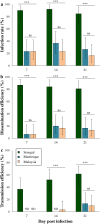Transmission potential of African, Asian and American Zika virus strains by Aedes aegypti and Culex quinquefasciatus from Guadeloupe (French West Indies)
- PMID: 31109248
- PMCID: PMC6534219
- DOI: 10.1080/22221751.2019.1615849
Transmission potential of African, Asian and American Zika virus strains by Aedes aegypti and Culex quinquefasciatus from Guadeloupe (French West Indies)
Abstract
Zika virus (ZIKV) is an arbovirus that has dramatically spread in South America and the Caribbean regions since 2015. The majority of vector incrimination studies available for ZIKV showed that Aedes aegypti mosquitoes are important vectors for this virus. However, several reports suggest that Culex quinquefasciatus mosquitoes may be implicated in ZIKV transmission in certain urban settings. In the present study, we evaluated the vector competence for ZIKV of Cx. quinquefasciatus and Ae. aegypti mosquitoes from Guadeloupe using African, American and Asian strains. The results demonstrated that Cx. quinquefasciatus is refractory to ZIKV infection whatever the strain tested at 7, 14 or 21 days post-infection (dpi), while ZIKV transmission was recorded in Ae. aegypti for all the three strains. The African ZIKV strain was better transmitted by Ae. aegypti (∼ 50% mean transmission efficiency) and with a shorter incubation period (7 dpi) when compared to the Asian and American strains (<14% transmission efficiency; incubation period of 14-21 dpi). Taken together, these results suggest that only Ae. aegypti mosquitoes are involved in urban ZIKV transmission in Guadeloupe and highlight a higher infectiousness of the African ZIKV strain in this mosquito species when compared to the Asian and American ones.
Keywords: Guadeloupe; Zika virus; vector competence.
Figures


Similar articles
-
Contrasted transmission efficiency of Zika virus strains by mosquito species Aedes aegypti, Aedes albopictus and Culex quinquefasciatus from Reunion Island.Parasit Vectors. 2020 Aug 6;13(1):398. doi: 10.1186/s13071-020-04267-z. Parasit Vectors. 2020. PMID: 32762767 Free PMC article.
-
Vector competence of Aedes aegypti, Culex tarsalis, and Culex quinquefasciatus from California for Zika virus.PLoS Negl Trop Dis. 2018 Jun 21;12(6):e0006524. doi: 10.1371/journal.pntd.0006524. eCollection 2018 Jun. PLoS Negl Trop Dis. 2018. PMID: 29927940 Free PMC article.
-
Culex quinquefasciatus from Rio de Janeiro Is Not Competent to Transmit the Local Zika Virus.PLoS Negl Trop Dis. 2016 Sep 6;10(9):e0004993. doi: 10.1371/journal.pntd.0004993. eCollection 2016 Sep. PLoS Negl Trop Dis. 2016. PMID: 27598421 Free PMC article.
-
Zika virus: An updated review of competent or naturally infected mosquitoes.PLoS Negl Trop Dis. 2017 Nov 16;11(11):e0005933. doi: 10.1371/journal.pntd.0005933. eCollection 2017 Nov. PLoS Negl Trop Dis. 2017. PMID: 29145400 Free PMC article.
-
Aedes albopictus is a competent vector of Zika virus: A meta-analysis.PLoS One. 2019 May 21;14(5):e0216794. doi: 10.1371/journal.pone.0216794. eCollection 2019. PLoS One. 2019. PMID: 31112569 Free PMC article.
Cited by
-
Assessing the role of two populations of Aedes japonicus japonicus for Zika virus transmission under a constant and a fluctuating temperature regime.Parasit Vectors. 2020 Sep 18;13(1):479. doi: 10.1186/s13071-020-04361-2. Parasit Vectors. 2020. PMID: 32948231 Free PMC article.
-
Bidirectional Interactions between Arboviruses and the Bacterial and Viral Microbiota in Aedes aegypti and Culex quinquefasciatus.mBio. 2022 Oct 26;13(5):e0102122. doi: 10.1128/mbio.01021-22. Epub 2022 Sep 7. mBio. 2022. PMID: 36069449 Free PMC article.
-
Experimental infections with Zika virus strains reveal high vector competence of Aedes albopictus and Aedes aegypti populations from Gabon (Central Africa) for the African virus lineage.Emerg Microbes Infect. 2021 Dec;10(1):1244-1253. doi: 10.1080/22221751.2021.1939167. Emerg Microbes Infect. 2021. PMID: 34085899 Free PMC article.
-
Differential intra-host infection kinetics in Aedes aegypti underlie superior transmissibility of African relative to Asian Zika virus.mSphere. 2023 Dec 20;8(6):e0054523. doi: 10.1128/msphere.00545-23. Epub 2023 Nov 9. mSphere. 2023. PMID: 37943061 Free PMC article.
-
Experimental Assessment of Zika Virus Mechanical Transmission by Aedes Aegypti.Viruses. 2019 Jul 31;11(8):695. doi: 10.3390/v11080695. Viruses. 2019. PMID: 31370135 Free PMC article.
References
MeSH terms
LinkOut - more resources
Full Text Sources
Medical
